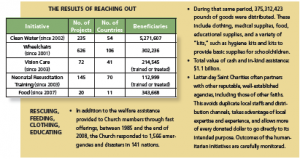 Last month, I highlighted the book, website and global effort called The Life You Can Save which advocates for people all over the world to donate 1 % of more of their income to causes working to alleviate global poverty. If you are interested in viewing a list of the causes that the website and others suggest, visit: the page Organizations you can give to and suggested organizations. Because I didn’t see LDS Humanitarian Services suggested by readers, I submitted it. It will hopefully appear on the site soon.
Last month, I highlighted the book, website and global effort called The Life You Can Save which advocates for people all over the world to donate 1 % of more of their income to causes working to alleviate global poverty. If you are interested in viewing a list of the causes that the website and others suggest, visit: the page Organizations you can give to and suggested organizations. Because I didn’t see LDS Humanitarian Services suggested by readers, I submitted it. It will hopefully appear on the site soon.
Then I read the article in September 2010 Ensign “The Church’s Humanitarian Efforts: Discipleship in Action” highlighting their efforts over the last 2 decades.
It’s always a good idea to do some fact checking into an organization before you donate money to them. You want to be sure that the money you are giving actually goes to the people they claim to serve and that the work that is done by the organization achieves its intended outcomes. The Ensign article helped me know more about LDS Humanitarian Services and see that they are actually involved in much more than I originally had thought.
To be honest, my perception of LDS Humanitarian Services for a long time was that they were really good at what I term the “band-aid” approach. In times of natural disaster or when providing aid to struggling communities, I believed they provided quick fixes that helped temporarily but did not address underlying causes contributing to the need for aid. Those efforts are necessary and important but after awhile its like pouring water into a bucket with holes when the help needed is a plug for those holes.
This Ensign article showed to me that the church does work to address the causes of poverty. The efforts described were: building wells to provide clean water that improves sanitation and increases productivity; providing wheelchairs to people with impaired mobility enabling them to be more involved in their care and support; treating and diagnosing vision problems in areas without adequate access to health care; training birth attendants in neonatal resuscitation to save babies’ lives; and address underlying causes of hunger, disease and malnutrition by teaching agriculture and livestock techniques.
A chart provides an impressive run down of the effects of LDS Humanitarian Services:
Impressively, the church reports that in the last 23 years, LDS Humanitarian services have contributed $1.1 billion in funds and 375,312,423 pounds of goods were distributed. These include clothing, medical supplies, food, educational supplies, and a variety of “kits,” such as hygiene kits and kits to provide basic supplies for school children.
I am encouraged to learn these things about LDS Humanitarian Services and feel that I can recommend the organization for their efforts to fulfill the mission of alleviating global poverty. When you go to pay tithing, please consider donating up to or more that 1% of your income to LDS Humanitarian Services to sustain and participate in their efforts.
To learn about other ways to be involved, visit: the How Can I Help? page. One of the suggestions is to serve in your local communities with organizations also working on efforts to alleviate poverty. Another suggestion is to become a service missionary or short-term specialist.
I dream of the day when my husband and I can service couple service missions for the church. In talking with the Humanitarian Services, there may be opportunities for parents of young children to be involved with short-term projects that may only require 1-2 weeks at a time a couple of times a year.
What else do you know about LDS Humanitarian Services? Have you be involved in any service projects with them? Can you recommend involvement with them? How would you like to be involved or which areas would you like to see them address?



Speak Your Mind